 |
 |
 |
 |
 |
 |
 |
What Should Men Wear for Farm Work
& Hard Labor?
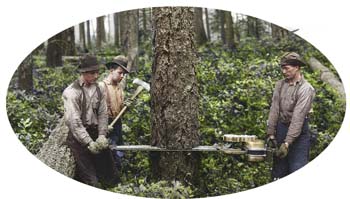
Washington State lumberjacks in 1929
Thank you for your articles on Traditional Catholic customs, they have been very helpful in forming my outward appearance to match my spiritual dispositions.
The piece on traditional hunting attire you cite very interesting and it reminds me of your pieces on clothing for hiking (here). What is the best way to dress for hard manual labor?
I live in the country but commute to an urban area for work. On my property I have chickens and farm vegetables. I also spend time cutting down trees and keeping the forest in shape. Currently I wear sweatpants and jeans while doing these tasks but I want to elevate my dignity by wearing proper clothing.
What would you suggest?
Our response follows:
We are pleased to see you taking the propriety in dressing seriously in your daily life. Many men have wrongly learned the modern one-dimensional view of propriety, that is, if your body is covered then you are proper and modest.
St. Thomas tells us differently: He states that modesty is a virtue derived from temperance, which moves the individual to behave and dress in accordance with the just limits of his state of life and position in society. Further, the man must always dress with two considerations in mind: his own dignity and that of his neighbor who sees him or is in his company.
It is of importance, therefore, for the farmer as well for the town mayor to have a dignified ensemble, different from one another, but both dignified and giving glory to God.
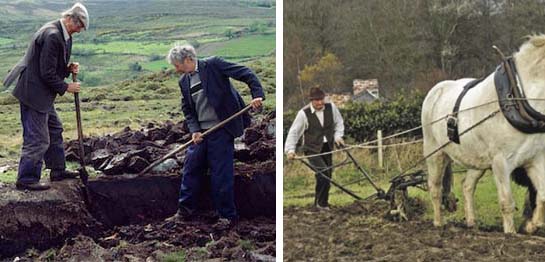
Irish turf cutters & plowsman: hard work but dignified dress
We see this modesty put into practice in an exemplary way in Catholic societies of the past, which gave birth to a great sacrality that permeated both the temporal and spiritual spheres of the Middle Ages. So, let us begin our examination of the clothing of the workman with a look at the dress of the medieval man.
Medieval peasant clothing
The medieval peasants typically wore linen or wool tunics that varied in color. The typical garb for laborers, the standard from the 8th to 14th century, consisted of doublets (short jacket), tunics and hoods. Women and men both wore aprons to protect their clothes when performing work that could soil their daily garb.
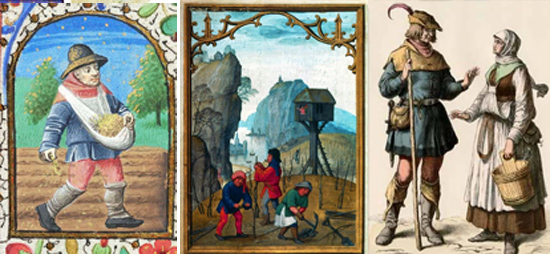
Medieval workers, simple but not sloppy or dowdy
Browns, grays and blues were common colors in the clothing of the peasantry, but yellows, greens and light reds and oranges could also be seen. Natural dyes procured from plants and minerals found in the fields and woods were used to give charm to the simple clothing. (1) It was not until more recent times that workman’s clothing became drab and colorless.
By the later Middle Ages the art of making clothing became more refined, not just for the nobility but for all the classes. Thus, the clothing of the working class also took on a more distinguished appearance.
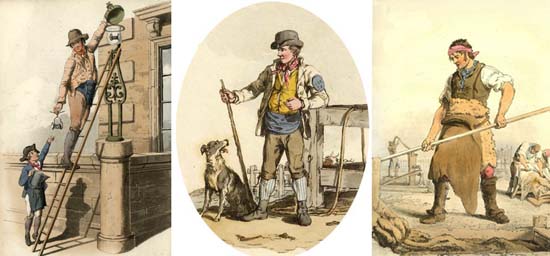
Regional clothing for workers developed in a very organic way;
left to right, a lamp lighter, a farm worker & a tanner
Regional clothing developed in a very natural and organic fashion as different peoples in varied places developed their own traditions. The mode of dress of the peasants and little people came to represent their particular psychologies and characteristics, the product of whole generations of Catholic men of good sense and a developing good taste enriched by the gift of true Faith.
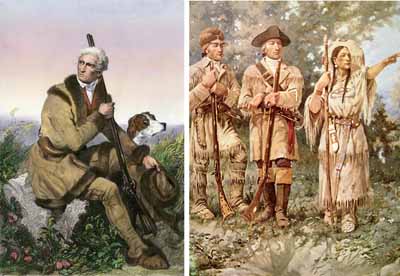
At left, Daniel Boone in typical garb, at right explorers Lewis & Clarke
with their Indian guide Sacagawea
Unique clothing styles reflecting the spirit of the people existed to some extent in America. Consider the fringed buckskins of the early American explorers and mountain men like Daniel Boone.
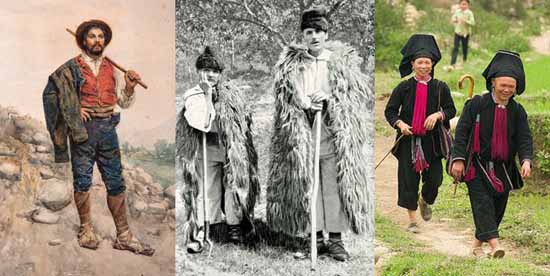
An Italian farmer, Moldavian shepherds & Vietnamese farmers in regional dress
The Mexican vaqueros and gauchos – who are said to have inspired the American cowboy – also had a very distinct gaucho costume.
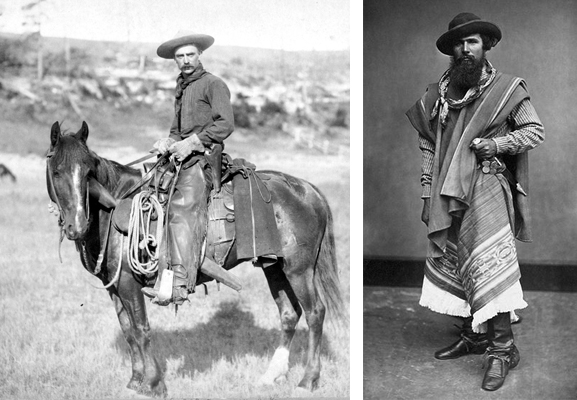
The American cowboy & the Spanish vaquero
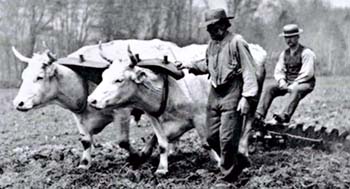
Hard work but dignified dress in the 1900s
It was a dress that respected the man and his work, and that upheld his dignity as a worker.
Overalls: An American look?
Overalls are often thought of as being an iconic American look; however, overalls as we think of them today did not exist until the 1830s. Originally a type of overalls was used in the 1700s as a protective covering. What began as an article of clothing that covered a man’s regular clothes became the mass-produced standard daily wear. (2)
How did that happen? Overalls became a common article of clothing when Levi Strauss patented his denim overalls in the 1870s. (3)

The American farmer in overalls, center, less dignified than
the Romanian at left & the German at right
It was in fact the Industrial Revolution that spawned this clothing. At first, overalls were only worn by miners and railroad workers who needed extra-sturdy clothing for the heavy work they undertook. Strauss’ denim pants and overalls were manufactured in great quantities, making them a cheap option for many poor workmen.
Farmers began adopting the new fad in the 1930’s during the Great Depression when the mass-produced overalls were easier to obtain. (4) Today, Americans think of farmers in their blue jean overalls precisely because of this change.
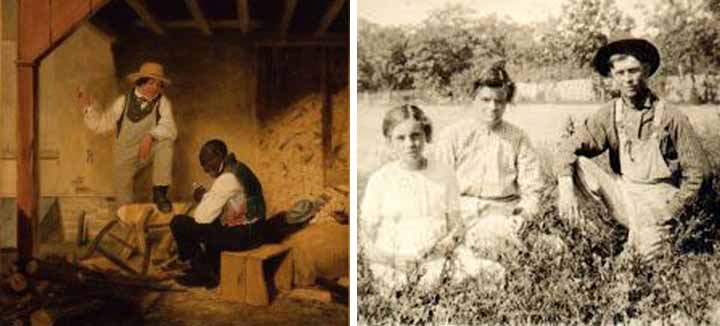
Overalls used for covering better clothes, at left, & the early 1900s style
The widespread use of overalls stripped the American farmer of not only a regional personality but also his personal dignity for the sake of convenience, comfort and cost. To break with this egalitarian spirit, therefore, it would be good to avoid overalls in your farm work and try to put together an outfit that has some distinctiveness.
While it must be acknowledged many manual laborers cannot have perfectly fitted and spotlessly clean clothing because their heavy work so easily wears and stains their clothes, there is no excuse for men not to be properly clothed.
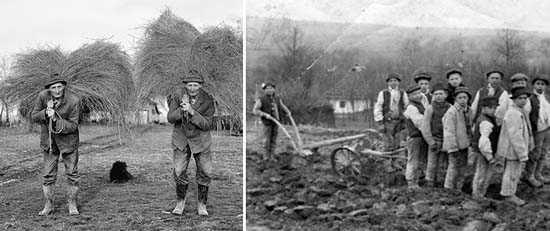
Early 20th century Hungarian peasant farmers & a group of farm boys
Practical advice on what to wear
Simple farm work and even log chopping can be done in long sleeve button up shirts with long pants. Sturdy pants, such as corduroy farmer work trousers with suspenders or cotton twill pants can be found both at specialty shops and thrift stores. You may even find that an old pair of durable dress pants work well.
Please, abandon the sweatpants, for they are neither appealing nor very practical for hard work. Jeans would also be good to abandon so as not to contribute to the egalitarian jean culture promoted by the Hippie Revolution. Canvas pants make a more proper outfit that has more personality and tends to look nicer than jeans, while being just as durable.
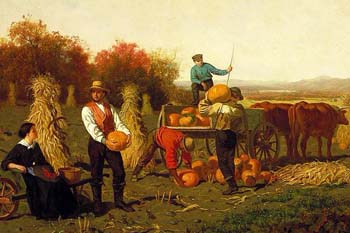
American farmers & the fall harvest; below, a woodcutting scene
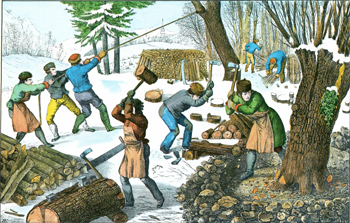
Wearing some form of necktie, be it a kerchief or type of cravatier, a hat, a vest also help to add distinction to your work clothes. And do not disregard work aprons as an exclusive women’s garment. Certainly it never was in the past. Consider using one not only as a practical aid to protect your clothing but also to add a note of distinction to the man in his workshop or barn.
As for footwear, save your tennis shoes for tennis and sports, and sandals for the beach. Sadly these casual shoes without socks have become a symbol of the casual modern egalitarian man of every age and every country. A leather boot or shoe with socks makes a counter-revolutionary statement.
A few online stores, Historical Emporium, Townsends and House of Bruar have an interesting selection of vintage men’s work clothing that may be useful, at least for inspiration as you form an organic model based on your heritage and the area where you live. Perhaps you can find some inspiration from the pictures featured in this article of modern day farmers from different countries who continue to dress with varying degrees of distinction, as well as pictures of log-cutters and farmers from in our not-so-distant past.
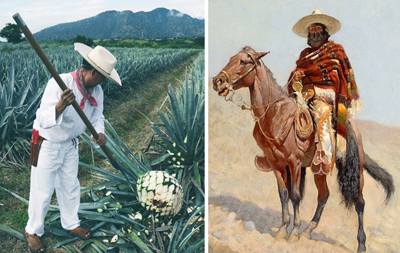
A Mexican farm worker in typical dress &
the colorful vaquero
The man in a well-ordered, composed and dignified work dress reflects the calm order and discipline of a virile and reasoning mind. It is a noble goal toward which to strive, and an integral component in the restoration of a Catholic Civilization.
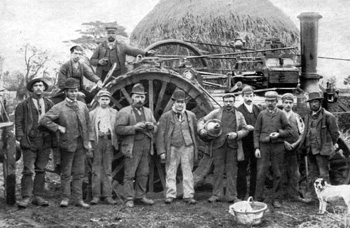
Threshing day on a farm, 1890
- Snell, Melissa. “Medieval European Peasant Clothing.” ThoughtCo, 7 Aug. 2019. https://www.thoughtco.com/european-peasant-dress-1788614 Accessed 17 May 2022.
- “The History of Overalls.” Blair Mountain Reenactment Society, 10 May 2011, https://blairmountainreenactment.wordpress.com/2011/05/10/the-history-of-overalls/ Accessed 3 May 2022.
- “Levi Strauss.” Wikipedia, 26 April 2022. https://en.wikipedia.org/wiki/Levi_Strauss Accessed 3 May 2022
- Kansas Historical Society. “Key Overalls”. Kansapedia, Dec. 2014, https://www.kshs.org/kansapedia/key-overalls/10162#:~:text=Overalls%20first%20appeared%20in%20the,railroad%20workers%20commonly%20wore%20them. Accessed 3 May 2022.
- Leventon, Melissa. What People Wore When: A Complete Illustrated History of Costume from Ancient Times to the Nineteenth Century for Every Level of Society. New York: St. Martin’s Griffin, 2017. Print.
- http://postej-stew.dk/2016/11/medieval-commoners-clothing-1000-1550/
- https://vintagedancer.com/1920s/1920s-mens-workwear-casual-clothes/





